
If you spend some time researching AI, you’ll find out the internet is heavy on that subject. Ever heard of AI voice clones, well this AI niche is gradually bringing its own changes too. AI voice clones are already being used in podcasts and video games. How long do you think it will take till the general public can directly access it? The answer is it’s probably sooner than you think. Samsung today revealed a function for its Bixby smart assistant that allows users to clone their voice to answer phone calls. With this feature Samsung is introducing if you receive a call but are unable to respond verbally, you can write out your response, and it will be read aloud in an imitation of your voice.
For now, many tests on this feature haven’t been reported because it is now only accessible in Korea as the Bixby Custom Voice Maker app for a select few Samsung smartphones (the new Galaxy S23, S23+, and S23 Ultra). We are unable to give in-depth knowledge of what it’s like but we are sure that the potential of this technology is enormous. A caveat depicts the voice quality can be terrible and the reaction time might be too slow to be of any value. With the abilities of the AI technologies we have today, producing lifelike duplicates of voices from just a few minutes of audio, cloning voices to answer calls is well within the reach of current technology.
It’s also not new to answer audio calls using a text interface. The function, known as Bixby Text Call on Samsung handsets, debuted with the maker’s One UI 5 Android interface. It was formerly exclusively accessible in Korean, but now an artificial voice in English is used (and only with version 5.1 of One UI). A similar feature provided by Google is called Call Screen, which enables you to reply to potential spam calls with an automated voice. But, Google’s service only allows you to select from a choice of pre-written responses rather than manually entering your own.
:no_upscale():format(webp)/cdn.vox-cdn.com/uploads/chorus_asset/file/24451252/Bixby_PR_main1.gif)
It’s not difficult to picture these capabilities evolving into more sophisticated, automated systems in the near future. After all, it wouldn’t be difficult to link a text-to-speech vocal clone of oneself to a chatbot like ChatGPT or (if you were in a really frantic mood) Microsoft’s Bing. It’s unclear what Samsung means when it says that in the future, user-generated voices would be “compatible with other Samsung apps beyond phone calls.”
In the event that you were feeling petty, you can use such a bot simply to waste the time of a spammer or summarize the information in your call. Making a speech copy of oneself and giving it tasks via a bot could actually make the tech industry’s long-promised idea that AI assistants will be able to handle our administrative tasks a reality. But it’s not just about avoiding conversations one would rather not have. The technology could also help those who have difficulty speaking or those with speech impediments to communicate more easily.
On the other hand, it could also lead to a variety of problems. Of course, Google promised comparable capabilities with its Duplex AI voice calls. These were released in 2018 as a means to use an AI voice to book reservations at restaurants automatically. However, opinions on the technology were divided, with many denouncing it as unethical and pointing out that it added to the workload of those who received the calls. Google’s current ambitions for the technology are unknown; the company ended support for Duplex on the web in late 2022.
Just like with any new technology, there may be drawbacks. The first concern is privacy. The process of making a vocal clone entails recording your voice, and even though Samsung guarantees the security of your data, there is always a chance that it could be compromised. Concerns exist over the technology’s potential for abuse, including the creation of hate speech and fraud.
For now, we are keeping our eye fixed on this technology and how it advances. In the near future when Bixby’s voice features roll out to the rest of the world when you pick up the phone one question on your mind would be if the person on the other end of the phone is indeed a human.
Discover more from TechBooky
Subscribe to get the latest posts sent to your email.







/cdn.vox-cdn.com/uploads/chorus_asset/file/24796730/whatsapp.png)